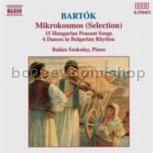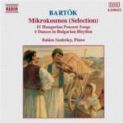Mikrokosmos - selections/3 Rondos/Three Hungarian Folksongs from Csik etc. (Naxos Audio CD)
Mikrokosmos - selections/3 Rondos/Three Hungarian Folksongs from Csik etc. (Naxos Audio CD)
* Estimated price converted from UK retail price
The Hungarian composer Bela Bartok was born in 1881 in anarea that now forms part of Romania. His father, director of an agricultural college, wasa keen amateur musician, while it was from his mother that he received his early pianolessons. The death of his father in 1889 led to a less settled existence, when his motherresumed work as a teacher, eventually settling in the Slovak capital of Bratislava (theHungarian Pozsony), where Bartok passed his early adolescence, counting among hisschool-fellows the composer Erno Dohnanyi. Offered the chance of musical training inVienna, like Dohnanyi he chose instead Budapest, where he won a considerable reputationas a pianist, being appointed to the teaching staff of the Academy of Music in 1907. Atthe same time he developed a deep interest, shared with his compatriot Zoltan Kodaly, inthe folk-music of his own and of adjacent countries, later extended as far as Anatolia,where he collaborated in research with the Turkish composer Adnan Sayg??n.
As a composer Bartok found acceptance much more difficult,particularly in his own country, which was, in any case, beset by political troubles, whenthe brief post-war left-wing government of Bela Kun was replaced by the reactionaryregime of Admiral Horthy. Meanwhile his reputation abroad grew, particularly among thosewith an interest in contemporary music, and his success both as a pianist and as acomposer, coupled with dissatisfaction at the growing association between the Horthygovernment and National Socialist Germany, led him in 1940 to emigrate to the UnitedStates of America.
In his last years, after briefly holding teaching appointmentsat Columbia and Harvard, Bartok suffered from increasing ill-health, and from povertywhich the conditions of exile in war-time could do nothing to alleviate. He died instraitened circumstances in 1945, leaving a new Viola Concerto incomplete and a thirdPiano Concerto more nearly finished.
The Allegro barbaro
of 1911, published in 1918, its very title a provocation, is a work of savage energy,firmly rooted in Magyar folk-dance. It marked a departure for Bartok from a style thatshowed the more overt influence of Debussy and, in Hungarian terms, of Liszt. Four yearsearlier he had arranged the Three Hungarian Folksongs
from the Csik District, collected in Transylvania and making use of melodies he had heardplayed on the shepherd's pipe, the tilinko. The FifteenHungarian Peasant Songs were arranged between 1914 and 1918 and were publishedin 1920. The work is made up of four groups, the first consisting of four old tunes, thefifth piece a Scherzo and the sixth a Ballad, in the form of a theme of asymmetricalrhythm and variations. The work is completed with a group of nine old dance-tunes.
Bartok wrote his Sonatina in 1915 and it was published inHungary in 1919. The work makes use of folk-tunes, presented, in general, in their moststraightforward form. The Bagpipers of the first movement, with its irregularities ofrhythm and suggestion of a drone bass, is followed by a short and heavily rhythmical BearDance. The Sonatina ends with a finale of increasing excitement. The work was latertranscribed for orchestra under the title TransylvanianDances, a description of its musical origin. The Three Rondos on SlovakFolk-tunes include one written in 1916, to which two more were added in 1927. Once againthe original material of the first rondo is presented more or less as transcribed, whilethe later two rondos make much freer use of the original material. The composer admittedto a pupil some difficulty in composing the second rondo, in which he had wanted toinclude a third theme, but this proved impracticable.
Mikrokosmos is a remarkable collection of pieces, forming acoherent introduction to the kind of piano technique necessary for performance ofcontemporary music, starting from the simplest beginning and leading to the concert piecesof the sixth and final volume. The first two books, written in 1926, were dedicated toBartok's second son, Peter. By 1937 the collection, still unpublished, included 153pieces, some of which the composer was including in his own recitals, as he did in thelast concert he gave in Hungary in October 1940 and the first he gave in the United Statesafter his emigration.
The first book of Mikrokosmos includes 36 short pieces, withoutthumb-crossing, and this elementary technique is continued in the thirty pieces of thesecond book, which opens with a short piece in the Lydian mode. No.40 is described as inYugoslav mode, and No.50 as a Minuet. The third volume contains a further thirty pieces.
No.73 is an exercise in sixths and triads, No.82 a Scherzo and No.87 Variations. The 25pieces of the fourth book, which now involves thumb-crossing, include No.100, in the styleof a folksong, Nos. 113 and 115, examples of asymmetrical Bulgarian rhythm, No.116 aHungarian melody and No.120 a melody in the mixolydian mode. In the fifth volume there areeighteen pieces, of greater length and complexity. The first piece, No.122, is a chordalstudy and No.126 an exercise in changes of time. No.128, a Peasant Dance, is followed by the alternating thirdsof No.129 and the varied touch called for in the Lydian mode Village Joke, No.130. Variedtouch is demanded again in the fourths of No.131, while No.133 offers syncopation andNo.135 the rapidity of a Perpetuum Mobile.
The sixth volume of Mikrokosmos contains only thirteen pieces,starting with the free variations of No.140, involving considerable complexity of rhythm.
No.144 is a study in the most discordant intervals, the minor second and major seventh.
No.146 an Ostinato, with a repeated bass pattern of Oriental suggestion, is followed by aMarch, No.147, of primitive character. The book ends with Six Dances in Bulgarian Rhythm, testimony toBartok's command of thematic material of popular origin, set off by his own idiomaticharmonic and textural treatment, which gives the traditional melodies a new energy.
Balazs Szokolay
The Hungarian pianist Balazs Szokolay was born in Budapest in1961, the son of a mother who is a pianist and a father who is a composer and professor atthe Ferenc Liszt Academy. He started learning the piano when he was five and in 1970entered the preparatory class of the Budapest Music Academy, where he completed hisstudies with Pal Kadosa and Zoltan Kocsis in 1983. He later spent two years at theAcademy of Music in Munich, with a German government scholarship.
Balazs Szokolay made an early international appearance withPeter Nagy at the Salzburg Interforum in 1979, and in 1983 substituted for Nikita Magaloffin Belgrade in a performance of the Piano Concerto No.1 of Brahms. He is now a soloistwith the Hungarian State Orchestra and has given concerts in a number of countries abroad,including Austria, Switzerland, France, Italy, Poland, the former Soviet Union, Bulgariaand Czecho-Slovakia. In September, 1987, he made his recital debut at the Royal FestivalHall in London. He has won a number of important prizes at home and abroad, including,most recently, success in the 1987 Queen Elisabeth of the Belgians Competition. He tookfourth place in the Leeds International Piano Competition in 1990, when his playing wasparticularly commended in the British press for its energy and imagination.







